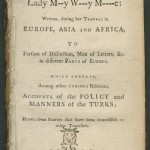Lady Mary Worthley Montague (1689 – 1762) was an English aristocrat and writer. In 1716, her husband was appointed British ambassador in Istanbul, where they spent 2 years.
Lady Mary’s own famous beauty had been marred by a bout with smallpox in 1715, and she had lost her brother to the disease. In Istanbul she witnessed the practice of inoculation against smallpox, variolation, which she called engrafting, and wrote home about it. Eager to spare her children, she had her son inoculated while in Turkey. On her return to London, she enthusiastically promoted the procedure, but encountered a great deal of resistance from the medical establishment, because it was an “Oriental” process.
In 1721, after a smallpox epidemic struck England, she had her three-year-old daughter inoculated by Charles Maitland, a physician who had been at the embassy in Turkey, and publicised the event. She persuaded Princess Caroline to test the treatment. Seven prisoners awaiting execution were offered the chance to undergo variolation instead of execution: they all survived and were released. Then six orphan children were inoculated: they all survived. In 1722 King George I allowed Charles Maitland to inoculate two of his grandchildren, children of the Princess. The children recovered.
About 3% of those inoculated developed smallpox and died. Others spent weeks recovering. However, that was preferable to catching smallpox in the wild, with its mortality rate of 20–40% and survivors left scarred and sometimes blind.
In response to the fear of inoculation, Lady Mary wrote an anonymous article describing inoculation as it was practised in Turkey. Inoculation gained general acceptance. In 1754 she was praised for bringing the practice to Britain.
In later years, Edward Jenner, who was 13 years old when Lady Mary died, developed the much safer technique of vaccination using cowpox instead of smallpox.



